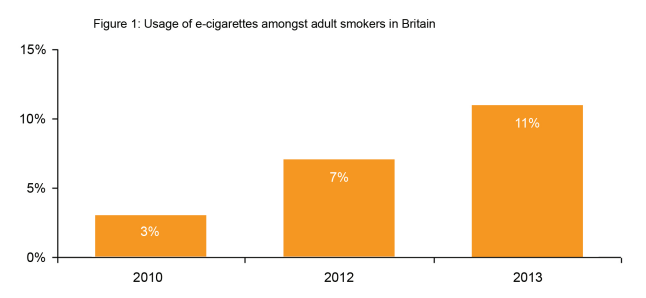E-cigarettes: harmful or helpful?
Are e-cigarettes a safe alternative to traditional cigarettes?
E-cigarettes have been the subject of much deliberation and controversy in the worlds of smokers and health experts since their arrival in the UK in early 2006, just before the smoking ban came into place on July 1 2007.
The e-cigarette has enabled smokers to get their hit of nicotine without the toxins and tobacco. They work with a rechargeable battery and atomiser. The liquid nicotine is vaporised and absorbed through the mouth while most of the ‘smoke’ produced is largely water vapour. E-cigarettes are seen as a healthier alternative to tobacco cigarettes for many reasons but one of the most compelling arguments for their health benefits is that they do not contain tar, and it is the tar in ordinary cigarettes that fills the lungs and can ultimately kill.
However, the health effects of e-cigarettes is something that has been much debated. Especially among health authorities unwilling to endorse a product that has not been subjected to years of testing.
The NHS website published the US Food and Drug Administration (FDA) findings that say the liquid and vapour of e-cigarettes do contain traces of toxins and the cancer causing chemicals nitrosamines and formaldehyde that are found in tobacco cigarettes. However they are about one thousandth less than the amount than would be found in a tailored tobacco cigarette.
The simple truth of the concerns is that e-cigarettes haven’t been around long enough to be tested for the effects they could have over a long period of use. Therefore, the advertisement of them as a healthier alternative to smoking or even a method of quitting has occasionally been disagreed with.

Currently in the UK, any product that contains nicotine and advertises itself to help people quit a nicotine addiction is considered to be a medical product and therefore bound by regulation by Medicines and Healthcare Products Regulatory Agency (MHRA). Many e-cigarette manufacturers will refrain from making these claims so as not to be regulated in this way.
The Advertising Standards Authority has recently taken steps to clear up uncertainties within the e-cigarette advertising market. This came after an advert for ‘Ten Motives’ e-cigarettes where the advertising watchdog ruled that claims stating it was “the healthier smoking alternative” could not be upheld. Ten Motives argued in its products defence by saying that it contained ‘none of the 4,000 or so harmful toxins and carcinogens found in conventional tobacco-based products’ and that it was considerably safer than smoking conventional cigarettes.
E-cigarettes have been much discussed within the European parliament. Their website currently states that there have been no studies on the long-term health effects on people and also claims that they contain harmful substances, although they haven’t specified what these substances are.
The EU website warns that as e-cigarettes contain nicotine, they could lead to addiction. However, according to Professor John Britton, who leads the tobacco advisory group for the Royal College of Physicians, nicotine addiction is no more dangerous than being addicted to caffeine.
He says:
“Nicotine itself is not a particularly hazardous drug. It’s something on a par with the effects you get from caffeine.”
The European Parliament also stresses the point that they have yet to be proved completely safe, and this is very true. However, it is argued by Dr Jean-Francois Etter, of the University of Geneva’s medicine faculty and Conservative MEP Martin Callanan, that regardless of this, they are still safer than tobacco cigarettes.
A recent decision by the European Parliament means MEPs have introduced new regulation and restrictions on what types of e-cigarette can be sold in member states. E-cigarettes will be classified as tobacco-containing products if they contain up to 20mg/ml of nicotine, following the adoption of the Tobacco Products Directive by the European Council. As of the 2013 draft on e-cigarette regulations in the EU, they propose that e-cigarettes carry the same health warnings and advertising restrictions as tobacco cigarettes.

This proposal angered Conservative MEP Martin Callanan, who said: “This is going in completely the wrong direction. E-cigarettes have the ability to convert thousands of smokers to ‘vaping’ as they call it. That is a thousand times safer than smoking tobacco cigarettes.”
“As a harm reduction measure we should be encouraging people to take up e-cigarettes not making it more difficult to obtain them. This is a very bad day for public health.”
Have e-cigarettes helped reduce the amount of smokers in the UK or not?
When the first smoking survey was produced in 1948, 82% of the UK’s population smoked some form of tobacco now 22% of adult men smoke and 19% of women according to 2014 figures by ASH (Action on Smoking and Health).
According to the ECCA UK (Electronic Cigarette Consumer Association) after their introduction, by 2007 there was thought to be 1,000 e-cigarette users in the UK.
A survey commissioned by ASH showed that 3% of smokers reported using e-cigarettes in 2010, a figure that increased to 7% in 2012 and 11% in 2013.
In 2012 e-cigarette sales rose dramatically from £2.5m to £23.9m
Is there a pattern or correlation between e-cigarette sales and tobacco smokers in the UK?
While the rise in e-cigarette sales increases, the Smoking in England (smokinginengland.info) statistics say that in the UK, cigarette smoking prevalence dropped below 20 per cent last year.
As of January 2014 according to ASH (Action on Smoking and Health) there are currently 1.3 million users of e-cigarettes in the UK. They claim this number is almost completely made up of current and ex-smokers and as many as 400,000 people have substituted smoking for e-cigarette use.
And while the health effects of e-cigarettes are still under study, the long term damage tobacco smoking can cause is widely known.
The British Medical Association state that over 81,400 deaths each year in those aged 35 years and over are caused by smoking and this accounts for 18% of deaths in the age group. As well as this, they estimate 461,700 hospital admissions for people aged 35 years and older are attributable to smoking.
Currently, it is clear that the lack of research should dissuade anybody to conclusively rule on the issue. In the mean time however, the research that has been carried out suggests e-cigarettes are a safe enough alternative to cigarettes and can be a great tool for anyone hoping to kick the habit.
Words: Megan Plumstead
@_Megan_May_




















